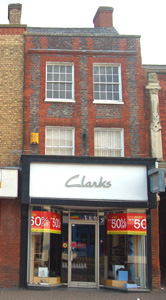39 High Street Leighton Buzzard

39 High Street in 1910 [Z50/72/126]
The Manor of Leighton Buzzard alias Grovebury was the principal landowner in the town before the 19th century. Bedfordshire & Luton Archives & Records Service has a full run of court rolls from 1393 to 1727 [KK619-715] and another full run from 1704 to 1867 [X288/1-23]. The service also has court rolls for other manor to own land in the town, the Prebendal Manor, from 1448 to 1459, 1588 to 1591, 1611 to 1622, 1627 and 1631 [KK792-1798]. A fair number of buildings in the High Street were originally copyhold and a detailed study of these court rolls would probably produce quite detailed histories for a number of properties and the sites on which they stand, though it would take many years of study.
39 High Street was listed by the former Department of Environment in 1975 as Grade II, of special interest. The building dates from the 18th century and is built in a local bond of brickwork under a steeply gabled Welsh slate roof.
A project called Our High Street Revisited 1819-2000 by Leighton-Linslade Local History Research Group [CRT130Lei58] aimed to use directories and census records to try to establish as full a history of use of the building in the High Street as possible. The results for Number 39 are as follows:
- 1819: owner: T. Price; occupier Joseph Pritchatt;
- 1830-1841: Thomas Price junior, linen and woollen draper;
- 1851: empty;
- 1861: William Woodstock, bootmaker;
- 1871-1972: James Willson, later Willsons, boot and shoe dealers;
- 2000: K Shoe Shop Limited;
- 2008: Clarks Shoes

39 High Street June 2008
Under the terms of the Rating and Valuation Act 1925 every piece of land and building in the country was assessed to determine the rates to be paid on them. Leighton Buzzard was assessed in 1927 and the valuer visiting 39 High Street [DV1/R56/68-69] noted that it was owned by Miles' trustees and occupied by T. W. Skevington and H. T. Hubbins, presumably shop managers for James Willson and Company Limited, at £65 per annum rent; the lease expired at Michaelmas 1927 and the new lease was to be £80 per annum.
In the basement were cellars measuring 11 feet by 24 feet and 11 feet by 13 feet ("not used, damp"); on the ground floor were shops measuring 11 feet 6 inches by 15 feet and 11 feet 6 inches by 9 feet, a back sitting room measuring 11 feet 6 inches by 13 feet an office of 11 feet by 14 feet and a lean-to workshop measuring 10 feet by 13 feet.
On the first floor were three stock rooms measuring 11 feet by 14 feet, 9 feet by 16 feet and 11 feet 6 inches by 15 feet 6 inches. Two store rooms measuring 11 feet 6 inches by 15 feet 6 inches and 12 feet by 10 feet occupied the second floor. There was a "store in roof". Outside was a W. C. in a small yard along with old brick and tile stabling used as stores measuring 19 feet by 16 feet with a loft over. A note of 26th November 1946 added to the description states: "rebuilt some years ago".